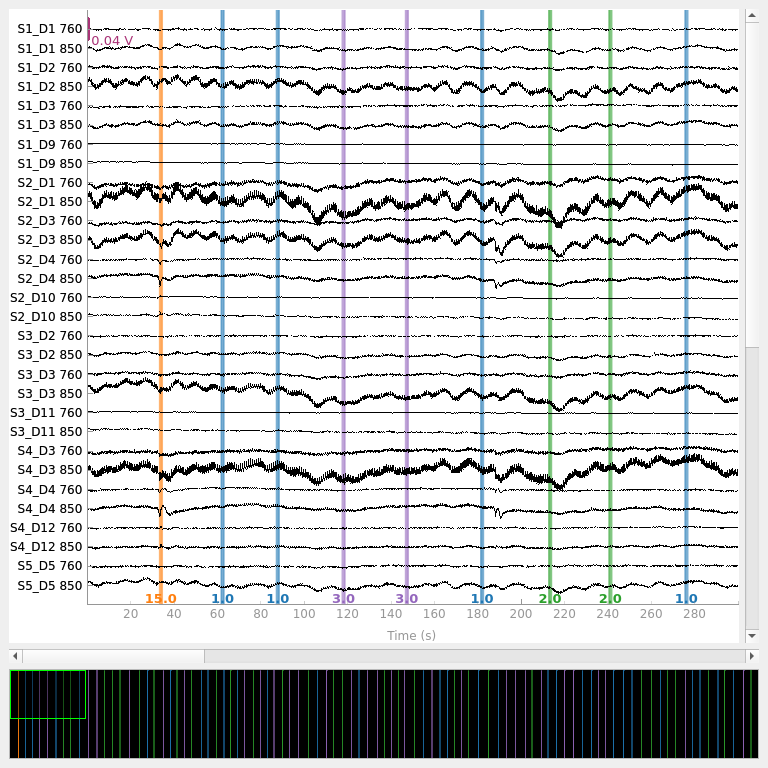Note
Go to the end to download the full example code. or to run this example in your browser via Binder
SNIRF Support in MNE#
SNIRF is a file format for storing functional near-infrared spectroscopy (fNIRS) data. The specification is maintained by the society for functional near infrared spectroscopy.
MNE Python and MNE-NIRS can be used to read and write SNIRF files respectively. In this tutorial we demonstrate how to convert your MNE data to SNIRF and write it to disk and also how to read SNIRF files. We also demonstrate how to validate that a SNIRF file conforms to the SNIRF specification.
You can read the SNIRF protocol at the official site fNIRS/snirf.
# Authors: Robert Luke <mail@robertluke.net>
#
# License: BSD (3-clause)
import os
import mne
import snirf
from mne.io import read_raw_nirx, read_raw_snirf
from mne.preprocessing.nirs import beer_lambert_law, optical_density
from numpy.testing import assert_allclose
from mne_nirs.io import write_raw_snirf
Import raw NIRS data from vendor#
First we import some example data recorded with a NIRX device.
fnirs_data_folder = mne.datasets.fnirs_motor.data_path()
fnirs_raw_dir = os.path.join(fnirs_data_folder, "Participant-1")
raw_intensity = read_raw_nirx(fnirs_raw_dir).load_data()
Write data as SNIRF#
Now we can write this data back to disk in the SNIRF format.
write_raw_snirf(raw_intensity, "test_raw.snirf")
Read back SNIRF file#
Next we can read back the snirf file.
snirf_intensity = read_raw_snirf("test_raw.snirf")
Compare files#
Finally we can compare the data of the original to the SNIRF format and ensure that the values are the same.
assert_allclose(raw_intensity.get_data(), snirf_intensity.get_data())
snirf_intensity.plot(n_channels=30, duration=300, show_scrollbars=False)

<mne_qt_browser._pg_figure.MNEQtBrowser object at 0x7fdb499e8ee0>
Validate SNIRF File#
To validate that a file complies with the SNIRF standard you should use the
official SNIRF validator from the Boston University Neurophotonics Center
called snirf. Detailed instructions for this program can be found at
BUNPC/pysnirf2. Below we demonstrate that the files created
by MNE-NIRS are compliant with the specification.
result = snirf.validateSnirf("test_raw.snirf")
assert result.is_valid()
result.display()
<snirf.pysnirf2.ValidationResult object at 0x7fda354db400>
Found 304 OK (hidden)
Found 522 INFO (hidden)
Found 0 WARNING
Found 0 FATAL
File is VALID
Optical Density#
MNE-NIRS cal also be used to write optical density data to SNIRF files.
raw_od = optical_density(raw_intensity)
write_raw_snirf(raw_od, "test_raw_od.snirf")
result = snirf.validateSnirf("test_raw_od.snirf")
assert result.is_valid()
result.display()
<snirf.pysnirf2.ValidationResult object at 0x7fdb2876d900>
Found 360 OK (hidden)
Found 466 INFO (hidden)
Found 0 WARNING
Found 0 FATAL
File is VALID
Haemoglobin#
And it can write valid haemoglobin data to SNIRF files.
raw_hb = beer_lambert_law(raw_od)
write_raw_snirf(raw_hb, "test_raw_hb.snirf")
result = snirf.validateSnirf("test_raw_hb.snirf")
assert result.is_valid()
result.display()
<snirf.pysnirf2.ValidationResult object at 0x7fdba03c0ee0>
Found 360 OK (hidden)
Found 466 INFO (hidden)
Found 0 WARNING
Found 0 FATAL
File is VALID
Total running time of the script: (0 minutes 6.221 seconds)
Estimated memory usage: 432 MB